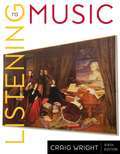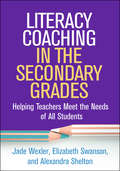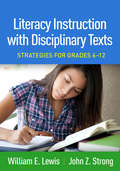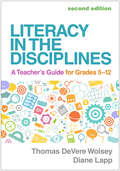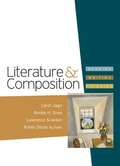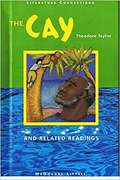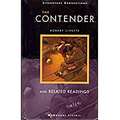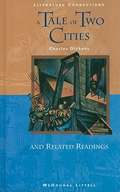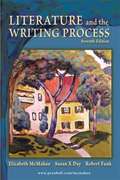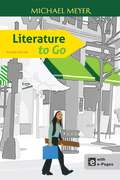- Table View
- List View
Listening to Music
by Craig WrightDesigned for an introductory course in music appreciation, this lavishly illustrated textbook encourages students to become active listeners who engage personally with what they are hearing. Sound files for the listening exercises are contained on the two accompanying CDs. Wright teaches music at Yale U. Annotation ©2007 Book News, Inc. , Portland, OR (booknews. com)
Literacy Changemakers: Bringing the Joy of Reading and Writing into Focus for Teachers and Students
by Kenneth Kunz Maureen Hall Rachel LellaThis inspiring book shows how K–12 teachers, literacy specialists and coaches, and school- and district-level administrators can work together to make needed instructional improvements while fostering a lifelong love of reading and writing. The book presents collaborative leadership strategies and research-based best practices for creating joyful, effective learning environments. It includes ways to evaluate and recalibrate literacy programs for sustainable change, provide students with a wide variety of engaging reading opportunities, meet the needs of English learners and adolescent learners, partner with families, and enhance professional learning and development. Teacher-friendly features include practical tips and "Stop, Think, and Take Action" sections in each chapter. Several reproducible forms can be downloaded and printed in a convenient 8 1/2" x 11" size.
Literacy Coaching in the Secondary Grades: Helping Teachers Meet the Needs of All Students (The Guilford Series on Intensive Instruction)
by Elizabeth Swanson Jade Wexler Alexandra SheltonToo many adolescent learners still struggle with reading. This much-needed guide shows how to support teachers in providing effective literacy instruction in the content areas, which can be intensified as needed within a multi-tiered framework. Adaptive Intervention Model (AIM) Coaching was created for grades 6–8, but is equally applicable in high school. The book gives instructional coaches an accessible blueprint for evaluating, developing, and reinforcing each teacher's capacity to implement evidence-based literacy practices. User-friendly features include case studies, end-of-chapter reflection questions and key terms, and reproducible tools. Purchasers get access to a companion website where they can download and print the reproducible materials--plus supplemental lesson plans and other resources--in a convenient 8 1/2" x 11" size.
Literacy Instruction with Disciplinary Texts: Strategies for Grades 6-12
by William E. Lewis John Z. StrongTo develop strong disciplinary literacy skills, middle and high school students need to engage with diverse types of challenging texts in every content area. This book provides a blueprint for constructing literacy-rich instructional units in English language arts, science, and social studies. The authors describe how to design interconnected text sets and plan lessons that support learning and engagement before, during, and after reading. Presented are ways to build academic vocabulary and background knowledge, teach research-based comprehension strategies, and guide effective discussions and text-based writing activities. Chapters also cover how to teach students to write argumentative, informative, and narrative essays, and to conduct discipline-specific inquiry. Special features include sample text sets and 24 reproducible planning templates and other teaching tools; purchasers get access to a Web page where they can download and print the reproducible materials in a convenient 8 1/2" x 11" size.
Literacy in the Disciplines: A Teacher's Guide for Grades 5-12
by Diane Lapp Thomas DeVere WolseyThis successful guide--now in a revised and expanded second edition--gives teachers effective strategies to support adolescents' development of relevant literacy skills in specific disciplines. Demonstrating why disciplinary literacies matter, the authors discuss ways to teach close reading of complex texts; discipline-specific argumentation, communication, and writing skills; academic vocabulary; and more. The book draws on revealing interviews with content-area experts and professionals in history, science, mathematics, literature, the arts, and physical education. Teacher-friendly tools include 21 reproducible forms that also can be downloaded and printed, "Try It On!" practice activities, lesson plans, chapter anticipation guides, and links to recommended online teaching videos. New to This Edition *Chapter on assessment. *Chapter on disciplinary literacies beyond school--in civic, professional, and personal life. *Expanded coverage of math, more attention to evidence and sources used in different disciplines, new and updated expert interviews, and advice on how both teachers and students can use AI tools productively. *Anticipation guides that invite reflection on key questions before, during, and after reading most chapters.
Literatura y arte: Intermediate Spanish
by Lynn Sandstedt Ralph KiteThis volume of the series features literary readings as well as artistic masterpieces from the Spanish-speaking world. This volume's 12 units are thematically tied to CONVERSACION Y REPASO. There is better correlation of these supplementary books in marginal annotations on each unit-opening and unit-closing page.
Literature & Composition: Reading, Writing, Thinking
by Renée H. Shea Lawrence Scanlon Robin Dissin Aufses Carol JagoFrom Carol Jago and the authors ofThe Language of Compositioncomes the first textbook designed specifically for the AP* Literature and Composition course. Arranged thematically to foster critical thinking,Literature and Composition: Reading • Writing • Thinkingoffers a wide variety of classic and contemporary literature, plus all of the support students need to analyze it carefully and thoughtfully. The book is divided into two parts: the first part of the text teaches students the skills they need for success in an AP English Lit course, and the second part is a collection of thematic chapters of literature with extensive apparatus and special features to help students read, analyze, and respond to literature at the college level. OnlyLiterature and Compositionhas been built from the ground up to give AP students and teachers the materials and support they need to enjoy a successful and challenging AP English Literature and Composition course. #xA0; Use the navigation menu on the left to learn more about the selections and features inLiterature and Composition: Reading • Writing • Thinking.
Literature & Composition: Reading, Writing, Thinking
by Lawrence Scanlon Robin Dissin Aufses Carol Jago Renee H. SheaNIMAC-sourced textbook
Literature Connections: A Tale of Two Cities and Related Readings
by Mcdougal LittellAmerican Literature textbook for high school
Literature Connections: Animal Farm and Related Readings
by Mcdougal LittellThe contents of the book are: Animal Farm: novel by George Orwell: a powerful fable that uses animals to reflect human political failure; The Stalin Epigram: poem by Osip Mandelstam; The Rebellion of the Magical Rabbits: short story by Ariel Dorfman-A fable about tyranny and rebellion; Crow Song: poem by Margaret Atwood; Harrison Bergeron: short story by Kurt Vonnegut-Total equality--a dream or a nightmare?; The Birds: short story by Daphne du Maurier-Human terror caused by a revolution of birds.
Literature Gold (Fourth Edition)
by Prentice-Hall StaffThe writer Edgar Allan Poe defined the short story as a brief tale that can be read in one sitting. Poe believed that such a story could have a more powerful effect and give greater pleasure than a longer tale read at different sittings.
Literature [Grade 9]
by Arthur N. Applebee Jim Burke Douglas Carnine Yvette Jackson Judith A. Langer Robert J. Marzano Mary Lou Mccloskey Donna M. Ogle Carol Booth Olson Lydia Stack Carol Ann Tomlinson Robert T. Jiménez Janet Allen et al.NIMAC-sourced textbook
Literature [Grade 9]
by Arthur N. Applebee Jim Burke Douglas Carnine Yvette Jackson Judith A. Langer Robert J. Marzano Mary Lou Mccloskey Donna M. Ogle Carol Booth Olson Lydia Stack Carol Ann Tomlinson Robert T. Jiménez Janet AllenNIMAC-sourced textbook
Literature and Thought: Who Am I?
by Julie A. SchumacherThe author through four sections, makes readers think critically and develop a deeper understanding of who they are, with each section addressing a specific thinking skill.
Literature and the Language Arts: Experiencing Literature (2nd Edition)
by EMC CorporationThe contents of this text are Part One--Genres in Literature: The Folk Tradition, Poetry, Fiction, Drama, Nonfiction, Informational and Visual Media; Part Two--Themes in Literature: The Search for Self, What is Talent?, Relationships, Courage and Perseverance, Journeys and Visions of the Future; Part Three--Language Arts Survey: Reading Resource, Writing Resource, Language, Grammar, and Style Resource, Speaking and Listening Resource, Study and Research Resource, and Applied English Resource, etc.
Literature and the Writing Process
by Elizabeth Mcmahan Robert Funk Susan X. DayA literature anthology, rhetoric, and handbook in one. Every chapter of this anthology includes coverage of the writing process to help students write more successfully about literature. The process-oriented instruction shows students how to use writing as a way of studying literature and provides students with the tools to analyze literature on their own. New to this edition: New photographs and images chosen to enhance understanding and appreciation of literature Expanded, updated discussion of researched writing (Chapter 17) Further instruction on the elements of argument and arguing an interpretation (Chapter 2) A new casebook on the poetry and prose of Langston Hughes
Literature for Life and Work, Book 1
by Christine Larocco Elaine Bowe JohnsonLiterature for Life and Work Book One (Grade 9) brings relevance and depth to any language arts and literature curriculum. This first volume and the other three exciting, colorful anthologies comprise a program that brings the traditional literature categories of study into the realities of the world of work. Project driven, with technical writing exercises and interpersonal skill development activities, each component of this series makes literature personal, practical, and pragmatic for all learners!
Literature to Go (2nd Edition)
by Michael MeyerThis book is a brief collection of stories, poems, and plays, accompanied by class-tested, reliable pedagogy and unique features that bring literature to life for students.
